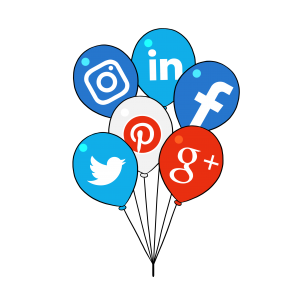
What Social Media Networks are Right for your Business?
Marketing Tips Social Media Marketing
Does your business have to be on every social media platform?
When you hear that Facebook Live, Periscope, and Snapchat are all the rage, you might think that you have to get on every single social media platform. Are you missing out by not jumping on all of them?
Of course you should keep your ear to the ground to stay aware of the latest trends so that you don’t fall behind on something that does prove to be very important. But it’s not the tool that’s the important thing.
It’s much more critical to understand who your target customers are.
When you understand who they are, you can determine where they are.
For some businesses, hopping on the bandwagon and rolling with the latest trend might be exactly the right strategy, but for most businesses, it’s better to focus on established platforms. Hit the right platforms strategically and hard.
Here is the targeting process that we use at Barker Social for all of our professional campaigns that you can apply to your own marketing:

- Identify your target customers
- Determine where they are
- Identify their needs
- Demonstrate that you understand their wants & needs
- Build a trusting relationship
- Explain how your products or services will fulfill those wants & needs
While there are many social media platforms, when you’re first getting started we recommend one of the following combinations for your target areas of focus:
- Facebook , Instagram, and Twitter for consumer, recreational, or entertainment businesses
OR
- LinkedIn combined with Facebook and Twitter for professional services
Tweeting does not come naturally to most people. I always hear the same reaction: “I don’t get it.” I can relate. I remember when I “didn’t get it” and just ignored Twitter as a tool. But here’s the thing; for most businesses, Twitter is one of the most important platforms.
When approached with the right strategy, Twitter is an excellent branding tool, though it does require a bit of a learning curve. What takes some getting used to is that Twitter is mainly a platform where businesses talk to each other. However, those businesses are run by real people, and when you engage those real people via their businesses, they grow to recognize and respect you. It’s a great way to build brand awareness.
Facebook
Facebook is almost everybody’s favourite tool because most of us already use it for our own social interactions. Great! …except that Facebook is constantly changing its algorithms. This means that no matter how many people “like” your page on Facebook, almost none of them will see your posts in their newsfeeds unless you pay to boost your updates. If you want Facebook to be effective, you need to create a budget to boost your posts. Otherwise, you can post every day but only reach a small percentage of people.
Once you understand how it works, you can work the system and reap excellent benefits, provided you have the right kind of business. When it comes to Facebook, it’s very important to know your audience. It just isn’t the right platform for certain types of businesses. Consumer, community, recreational, entertainment, etc. are all industries that work on Facebook. Professional services usually don’t.
Sure, you can have a Facebook page, just don’t make it a primary focus area for your marketing campaign unless you’re ready to invest a solid budget to boost your posts. Paid advertising on Facebook is very effective, so remember, even a small budget goes a long way.
This is where it’s at for professional services. LinkedIn is a great place to share professional insights and updates. You can share blog posts that link to your own blog, you can publish articles directly on LinkedIn that will reinforce your expertise, and you can also share information from external sources that relate to your industry.
LinkedIn is the right place for all the serious, professional content that feels inappropriate on Facebook. Work to build your network and focus on your personal profile to build your own brand as well as your business page. Share the content from your business page in your personal newsfeed with additional commentary so that the content you’re sharing feels both professional and also conversational.
Instagram is a great tool for any type of business that’s naturally visual. If you have a business related to food, recreation, fashion and style, beautiful objects, people, or places, Instagram could be great for you. I recommend Instagram for restaurants, retail, and other highly visual businesses
If your business isn’t particularly visual, such as a professional service that’s mainly pushing “paper” around, put Instagram on the back burner. You might return to it in a creative way once your more targeted platforms are really working for you.
The nice thing about Instagram is that you can use as many #hashtags as are applicable and generally, the more the better. Put most of the hashtags at the end of your update, with an occasional hashtag in the middle of the sentence if you really want to emphasize it.
This is a great option for businesses that will be generating a lot of imagery and a high volume of blog posts. The most effective Pinterest campaigns are those with strategic visuals. These are usually created to include written “hooks” that will draw people to click through to the website because to make Pinterest effective as a marketing tool, you definitely want to be driving people to your business page! Linking to a blog post on your website is ideal.
I advise that small business owners be cautious about Pinterest when first starting out. You can certainly start a designated Pinterest board but it can be a major distraction, sending you down a time-consuming rabbit hole without much return. Unless you have a completely visual business, like a fashion store or restaurant, set Pinterest aside and focus on the other platforms.
Pinterest, and an increased Instagram focus, can be good areas to build up once you’ve established a solid Twitter and Facebook base for at least 6+ months.
Hone in on specific platforms according to your customers. Check your analytics regularly to check your progress and your return on both your financial investment and also your time investment.
Remember, one month is not enough time to effectively establish a successful campaign, but it’s enough time to set a benchmark to mark your progress. Check in and conduct monthly reporting to make sure that your efforts are growing your networks. Tweak and course correct your campaign on a monthly basis if you aren’t getting your desired results.
If you need help with your social media marketing plan, either for long term marketing or for a specific product launch or campaign, please don’t hesitate to contact us. We’d be happy to discuss your needs and help you achieve your marketing goals!



